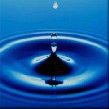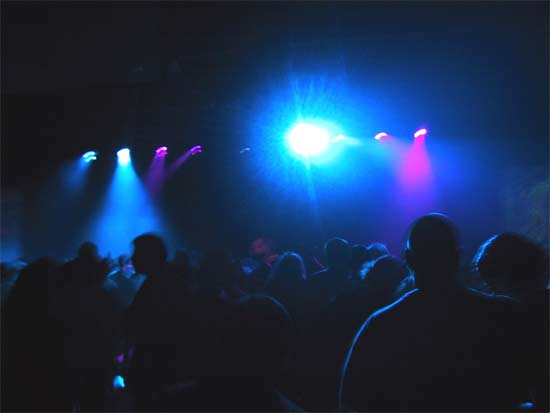
The role of the Music in Rave Culture
"The Self, configured as a unitary, autonomous individual in possession of an essential subjectivity, is one of the linchpins of modern social organization" (DeNora 32).

Within modern "rave culture", how the individual identifies him/herself as a member of that rave culture (ie. as a "raver" or other member of the "rave"community) is largely dependent on his/her personal connection to and appreciation of the music that is typically played at raves, clubs, and at related social functions. This personal connection to the music develops over the course of time as the individual hears this music at "raves" or elsewhere, and so begins to correlate the experience of raving with the aural pleasures of electronica. As the individual hears the music more and more, he/she will typically begin to develop an understanding of the music, which will further his/her appreciation of the music, and additionally enhance his/her personal connections to it. Whether it be techno, house, trance, jungle, trip hop, or otherwise, electronica is a form of music which is unique and can be easily differentiated from other forms of music pertinent in alternative cultural sectors of society. As Tia DeNora explains, "music...may provide a means for self-interpretation, for the articulation of self-image and for the adaptation of various emotional states associated with the self in social life" (32). Electronic music undoubtedly acts as an artistic medium through which the "raver" identifies him/herself distinctly as a member of the rave culture. It also affects his/her individuality, as being a member of the "rave scene" inevitably affects the individual, influencing his/her friends, activities, and general preferences. Electronica also has an immediate effect on its listeners. The DJ at a rave or club strives to create music that puts his/her audience in a positive, highly-energized emotional state condusive to dancing, socializing, and just, generally, raving.
 One
woman who participated in Tia DeNora's study noted that music "'can inspire
you', 'bring understanding', 'raise you to another plane'" (34). The music
played at raves is a key element--the key element--which defines rave culture.
It is the music: the pounding of the bass, the majestically-intertwined electronic
melodies, precisely-blended orchestrations of snare drums, hi-hats, and light
taps, that sets the scene for a rave. It is the music which creates the primary
layer of atmosphere within the space, drives people to dance, and subtly encourages
them to dance and move in a particular way. It is the music that throbs like
a giant heartbeat, driving the life of the party as the night wears on, infusing
its attendees with boundless energy, elating them and encouraging them to integrate
and socialize with one another. "ravers prefer 120 BPM because it simulates
the heartbeat as heard in the womb" (Steins). At a rave, the music acts
as "a means for creating, enhancing, sustaining, and changing subjective,
cognitive, bodily, and self-conceptual states" (DeNora 35).
One
woman who participated in Tia DeNora's study noted that music "'can inspire
you', 'bring understanding', 'raise you to another plane'" (34). The music
played at raves is a key element--the key element--which defines rave culture.
It is the music: the pounding of the bass, the majestically-intertwined electronic
melodies, precisely-blended orchestrations of snare drums, hi-hats, and light
taps, that sets the scene for a rave. It is the music which creates the primary
layer of atmosphere within the space, drives people to dance, and subtly encourages
them to dance and move in a particular way. It is the music that throbs like
a giant heartbeat, driving the life of the party as the night wears on, infusing
its attendees with boundless energy, elating them and encouraging them to integrate
and socialize with one another. "ravers prefer 120 BPM because it simulates
the heartbeat as heard in the womb" (Steins). At a rave, the music acts
as "a means for creating, enhancing, sustaining, and changing subjective,
cognitive, bodily, and self-conceptual states" (DeNora 35).
"Music is an accomplice in attaining, enhancing, and maintaining desired states of feeling and bodily energy" (37). At a rave or party, the DJ plays the role of both the puppetmaster and the entertainer, "mixing songs together using different pitches, different speeds, and an equalizer to create an ever-flowing, ever-changing wall of sound...techno songs...are...reinterpreted and mixed with other techno songs, creating a spontaneous new song" (Steins). The DJ carefully selects which records to play in order to optimally sustain and elevate the general mood, energy level, and plane of consciousness of the raves's participants. A good DJ will seamlessly mix one track over another, blending the two tracks so subtly, at first, that the changes are virtually indetectable, gradually layering melodies, rhythms, and scattered beats overtop of one another. He/she will constantly add new streams of sound to the mix, while others slowly diminish, interlocking the two tracks in such a way that the tracks sound as if they are naturally morphing as the DJ switches from one record to another. While he/she is doing this, the DJ is perpetually monitoring the energy levels and patterns of sound that he/she is creating, ensuring that his/her performance is relentlessly driving the audience to dance. The DJ understands the power of music, and is an expert in aural trickery and manipulation. He/she clearly realizes that music's "specific properties--its rhythms, gestures, hamonies, styles, and so on...[can be used] to cast an aspired state" (DeNora 38) over his/her audience.
DeNora notes that the "music is used by respondents to ease them on to courses of action and modes of aesthetic agency that they actually desire" (39). At raves, it is the music that initially captures the audience's awareness, gently easing them into a postitive, sociable, highly-energized state, compelling them to dance and integrate with one another.
"The music that the DJ creates
spontaneously is a text. 'The dancer then in turn re-interprets this text thr ough
movements of the body…the ‘reader’ therefore, whether in the role of dancer,
DJ, or user of sampling technology contributes a mindset that is culturally
specific and productive in itself.' (Rietveld 2) The DJ then must sense the
communal energy of the group, and adjust his mixing accordingly. The DJ provides
the path for the ravers to walk on, as the ravers change direction, so must
the DJ. It is a constant process of energy being transmitted and refracted,
creating a tangible feeling" (Steins).
ough
movements of the body…the ‘reader’ therefore, whether in the role of dancer,
DJ, or user of sampling technology contributes a mindset that is culturally
specific and productive in itself.' (Rietveld 2) The DJ then must sense the
communal energy of the group, and adjust his mixing accordingly. The DJ provides
the path for the ravers to walk on, as the ravers change direction, so must
the DJ. It is a constant process of energy being transmitted and refracted,
creating a tangible feeling" (Steins).
It is the music that breaks the ice at a rave, tha immerses the ravers in its complex patterns of rhythmical splendor, motivating them to dance. Social boundaries crumble along with personal inhibitions, as everyone is brought together by the music. It acts as a cohesive, a binding agent. It is enjoyed by everybody; it is a shared experience.
Music is the driving force behind the rave scene. Without the music, there would be no scene, no raves, no ravers. The euphoric energy and constant ripple of sound and conversation would cease entirely. The space, once filled with dancers, socialites, and hazy streams of multicoloured light, would become an empty warehouse filled with silence, cigarette butts, and alienated strangers. At a rave, the music is used both to create and "to seal off an environment" (DeNora 43).
"Music is an active ingredient
in the organization of the self, the shifting of mood, energy level, conduct,
style, mode of attention, and engagement with the world" (44). The style
of music played is the distinguishing feature of a rave, and presence at raves
enables individuals to identify themselves as ravers. It is the music which
initially allures the individual to dance and participate in the experience
of raving. It is that experience which prompts the individual to attend more
raves. It is his/her regular attendance at raves which may result in that individual
identifying him/herself as a raver, and member of the rave community. Many young
people, especially those "between 17 and 25" (Steins) may identify
themselves as ravers. They may dress however  they
please, but it is a common sight to see a raver dressed in big pants and little
colourful t-shirts, adorning their bodies with glitter and brightly-coloured
jewelry, spending time in clubs and warehouses late at night, dancing until
the break of dawn. The people at these parties may call themselves ravers, or
perhaps just people who "like to rave". They may prefer house music,
techno, or drum'n'bass. They may be menial workers, students, university graduates,
or trained professionals employed in a vast spectrum of fields.
they
please, but it is a common sight to see a raver dressed in big pants and little
colourful t-shirts, adorning their bodies with glitter and brightly-coloured
jewelry, spending time in clubs and warehouses late at night, dancing until
the break of dawn. The people at these parties may call themselves ravers, or
perhaps just people who "like to rave". They may prefer house music,
techno, or drum'n'bass. They may be menial workers, students, university graduates,
or trained professionals employed in a vast spectrum of fields.
Outside of the rave, the attendants do not necessarily have a whole lot in common. Within the confines of the space, however, magic is in the air, as the DJ spins a glistening web of music, creating an atmosphere of peace, love, unity, and respect where one can dance, spirits soaring, as the their troubles dissolve into a state of sheer euphoria.
 For
more about Rave culture, take a look at Julia's website on Rave culture and
spirituality.
For
more about Rave culture, take a look at Julia's website on Rave culture and
spirituality.